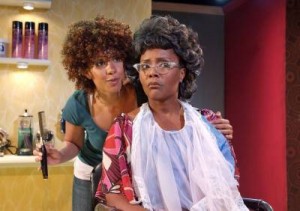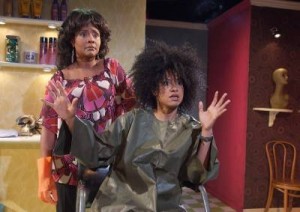
Tonya Pinkins and Tracie Thoms are two actresses who could get together on a stage and captivate audiences merely by reading the proverbial phone book. Performing in a winner of a play like Zina Camblin’s And Her Hair Went With Her, the duo is theatrical magic.
Pinkins is beauty salon owner Jasmine and Thoms her assistant Angie, but that’s not all. The two Broadway star portray a host of other characters—brilliantly—during the plays lickity-split 80 minutes.
It’s 2003 and Jasmine has won a pair of tickets to a Nina Simone concert by calling in to a radio program and answering the question “Name a Nina Simone song.” If Angie is to get the second ticket, she will have to answer three much more difficult questions about the divine Miss Simone, or the ticket will go to someone else, says Jasmine. Nina Simone is about the only thing Jasmine and Angie can agree about these days. “This women’s studies thing is going to your head,” Jasmine tells her friend and employee, whose hero is another Angela, socialist organizer Angela Davis.
First to visit the salon is Crystal (Pinkins), beneath her blonde Farrah Fawcett hairstyle appears, not surprisingly, to be African American. Not so, insists Crystal, who goes on to explain (in her best valley girl voice) “How I Became White.” It was 1978 and her first day in the 3rd grade. Her teacher divided the class into fast readers (the Hares) and slow readers (the Tortoises) and guess where Crystal got put, with all her black classmates? That is, until little Crystal showed teach that she was a whiz at reading, prompting an amazed “Are you really white under that black skin?” and a promotion to Hare. And Crystal has been proudly “white” ever since!
Next to arrive for her hair appointment is actress Debbie (Thoms), who’s getting her perky flip styled for an audition. Jasmine offers to pretend to be the casting person, to which Debbie eagerly agrees, leading to the following spot-on exchange between performer and person in power:
Debbie: Hi, I’m Debbie Dyer!
Jasmine: NEXT!
Debbie: What are you doing!?!
Jasmine: Isn’t that what they do?
Thoms is absolutely hilarious as she assures Jasmine that she can be anything a casting person could possibly want. When her monolog from “For Colored Girls Who Have Considered Suicide When the Rainbow Is Enuf” goes kerplunk, Debbie reassures casting lady, “I can play street.” She gives street her best shot, but it comes out “hooch.” Next Debbie attempts a monolog about her pet doggie who was killed when Debbie was only nine. “Why? Why?? WHY??? WHY???” screams Debbie, which provokes a thumbs down from Jasmine (in Simon mode, or is that Paula or Randy?)
Back to Jasmine and Angie, who’s got a daughter, Monica, and an ex named Leroy who didn’t even buy his daughter a birthday cake. So why does Angie seem so full of herself at times? “Girl, just cause you took some classes in college, you think you won the Pulitzer Sur-Prize. Surprise! You never won one!”
Thoms next dons yet another wig, a humungous product-free afro, to play Keesha, a young woman who is proud to be a BOC (Black Obsessive Compusive) and proves it by bringing her own smock, disinfectant wipes, hand disinfectant gel, and toilet seat covers for the barber’s chair.
Then it’s back to Pinkins as Bernadette, a salt-and-pepper-wigged older schoolteacher who plops herself down and promptly begins telling Angie her life story. After starting off as a full-time exotic dancer up north (she was hot enough to “make even a white man want to slap his mama”), Bernadette then joined the Negro Ensemble in New York. Off to Hollywood, she was “almost the maid” on The Jeffersons, before becoming a teacher, one seemingly unable to leave her students behind her when she exits the school campus, for she keeps cussing out her students at intervals during the life story recitation.
Last to visit Jasmine’s salon is Thoms as the perky secretary at Coffman Realtors. Correction: “He calls me his secretary but I’m really his assistant,” she says proudly. It’s apparently no problem for this secretary/assistant to leave the office unattended. She just takes office calls on her cell phone, pretending to be hard at work until finally, she tells a caller, “Sorry, we’re closed. We had a bomb threat.” (Since the girl’s been fired four times in five weeks, it’s unlikely that she’ll still be working for Mr. Coffman at her next hair appointment.)
Throughout the second half of And Her Hair Went With Her, Angie pays several visits to a nearby prison to meet with Felicia, a tough lesbian death row inmate whom Angie is interviewing. Pinkins does the most powerful dramatic acting in an evening of primarily comedic fun as the unrepentant killer. Gone are any traces of a smile as Pinkins disappears into the skin of a street tough who murdered the man her ex, Cassandra, left her for after he had killed Cassandra.
Camblin’s play is not only a tribute to sisterhood, to Nina Simone, and to Angela Davis, but a darned fine piece of writing, directed to perfection by Diane Rodriguez, who keeps her two actresses on the same page, never letting the performances become caricature.
Pinkins nearly won a Tony for Caroline, Or Change (and many feel she was robbed of what should have been her prize). L.A audiences thrilled to her bravura work as Caroline when the Broadway production transferred to the Ahmanson. Exactly four months ago, the Broadway star gave a sensational performance at the Celebration in As Much As You Can, so to have Pinkins appear again so soon in an intimate theater setting is a real gift for L.A. playgoers. Superlatives are in order for her work here, as she disappears into character after character.
Thoms received unanimous raves for her work as Joanne in the film version of Rent. Here, the petite charmer is an absolute delight from start to finish. Even if she were only playing one character here, the earnest and sympathetic Angie, her performance would be rave-worthy. That she also transforms herself into a ditzy actress, an obsessive-compulsive nut case, and the world’s worst employee makes for an acting tour de force.
Sandra Burns’ beauty shop set and costume design create the perfect milieu and attire for Jasmine and Angie, and Tony Mulanix’s lighting is likewise excellent, especially in prison scenes with Angie and Felicia. Adam Phalen’s sound design weaves the songs of Nina Simone throughout the play. Patricia E. Doherty’s original wig designs (with Judi Lewin as wig consultant) are, as might be expected, integral to the plot and character-perfect.
Clothes may make the man, but hair makes the woman, or at least it does in the laugh out loud hilarious And Her Hair Went With Her.
The Fountain Theatre, 5060 Fountain Avenue, Los Angeles.
www.FountainTheatre.com
–Steven Stanley
May 9, 2008
Photos: Ed Krieger





 Since 2007, Steven Stanley's StageSceneLA.com has spotlighted the best in Southern California theater via reviews, interviews, and its annual StageSceneLA Scenies.
Since 2007, Steven Stanley's StageSceneLA.com has spotlighted the best in Southern California theater via reviews, interviews, and its annual StageSceneLA Scenies.







 COPYRIGHT 2024 STEVEN STANLEY :: DESIGN BY
COPYRIGHT 2024 STEVEN STANLEY :: DESIGN BY